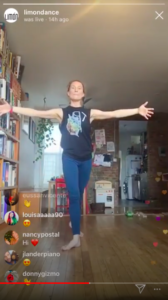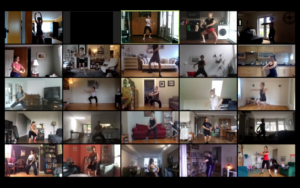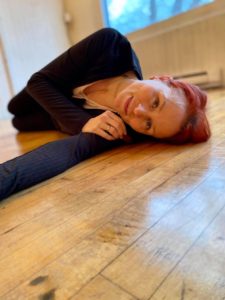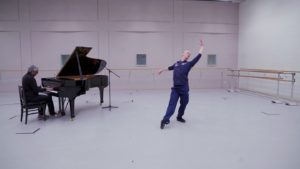Online Classes: Sampling some of the best worldwide - Vancouver Ballet Society
- Home
- Features 2020 - 2023
- Online Classes: Sampling some of the best worldwide

By Jenn Edwards
The pandemic has transformed how dancers take class. While the lockdown is temporary, now that virtual class infrastructures are in place many organizations and teachers will continue to have online offerings into the fall, even in locations that are cautiously re-opening. A screen can never replace the experience of a three-dimensional teacher or the energy of a studio filled with moving bodies, but virtual platforms have made world-class teaching from across the globe much more accessible, creating broad online communities that didn’t exist before COVID-19. Below are some favourite online classes for intermediate, advanced and professional dancers.
Graham, Cunningham and Limón — New York

To replace their in-person daily open classes, three American organizations — Martha Graham Dance Company, Merce Cunningham Trust and José Limón Dance Foundation — have been providing free classes on Instagram Live since early in the pandemic, taught by current and former company members. The modern dance techniques created by their legendary namesakes each develop different sets of strengths. While Cunningham uses isolation to mobilize the spine, legs and feet, Limón takes a more whole-body approach focusing on suspension, drop and swing. Graham technique, the oldest of the three, includes floor work and centre practice emphasizing contraction, release and spiral, all stemming from the pelvis
Follow these companies to take class live from Monday to Friday, or mine their IGTV pages for past classes. For those seeking to go deeper, Merce Cunningham Trust has released instructional videos for some of their repertoire, and Limón Dance Company will be hosting an online Trainee Program, LimónPro, from September 21-November 20, 2020.
www.marthagraham.org www.mercecunningham.org www.limon.nyc
GMD — Toronto

GMD (Great Moving Dancers) is a major training hub for Canada’s largest modern and contemporary dance community. These advanced drop-in classes normally take place in Toronto’s Cabbagetown neighbourhood three mornings a week. Now anyone can try them out on Zoom on Tuesday and Thursday mornings. “Although class in a tiny space does have its limitations, it was crucial for us to go online to nourish and sustain dancers,” says veteran modern dancer Kenny Pearl, who produces the class series.
For a suggested donation of $5.00, dancers can train with exceptional teachers like Bonnie Kim, Johanna Bergfelt, Louis Laberge-Côté and Darryl Tracy. Each 75-minute class may include a contemporary barre, floor work, improvisation or gesture-based phrases. There are also several pre-recorded videos available for free on the GMD website, for those who can’t make the live time slots.
Gaga — Tel Aviv
For Saar Harari, Gaga classes are about “going back home to the body, so it was a natural progression to bring it into peoples’ homes.” Currently, Harari teaches a few times per week from his Tel Aviv home, in addition to his role as artistic director of Gaga. Also, to offer support during the transition to online instruction, the technique’s founder Ohad Naharin has been hosting online sessions for certified Gaga teachers once a week. Harari says that the online teaching “has made us much more precise with language and physicality.”
While based on a progression of sensorial and often rigorous tasks, Gaga is ultimately self-guided, with an emphasis on listening to one’s own body. The movement language has become a global phenomenon in recent years, with Gaga Dancers classes for the professional community and Gaga People for the general public. Currently classes on Zoom are held six days a week, multiple times a day, and there are usually hundreds of people in a single class. Soon a donation-based system will be replaced by a membership model, with options for both drop-in and unlimited classes per month.
Jill Henis — Vancouver

A few days after the COVID-19 shutdown hit Vancouver, independent dance artist Jill Henis began teaching contemporary ballet from her kitchen for free on Facebook. Her Kitchen Series quickly became known among the west coast dance community as a space to gather and take a challenging, yet feel-good, class. “I didn’t want to charge a fee because I felt that the exchange of energy and attention had greater value,” says Henis.
Henis has four decades of experience studying, performing and teaching dance. Her weekly schedule now includes three online classes at Harbour Dance Centre, where she’s on staff, as well as two classes a week through the Dance Deck, which are taught in person, and simultaneously livestreamed, from Scotiabank Dance Centre.
Henis’ community-minded approach has struck a chord with dancers, as word of mouth has secured her ballet classes a strong following during these strange times.
Access to Henis’ Kitchen Series and Dance Deck classes is through her Facebook profile, and you can find her Harbour Dance classes on the studio’s website.
Dutch National Ballet — Amsterdam

In March, during the height of the lockdown, Dutch National Ballet started releasing videos in lieu of company classes. In their first video, Junior Company Director Ernst Meisner explains, “We thought it would be really good to stream a class, first of all to our dancers, but also to all the dancers around the world who want to join us.” Eleven videos have been posted in total, which now have hundreds of thousands of views each, and will be online indefinitely.
Meisner leads the classes to exquisite live music by pianist Rex Lobo. Each class is roughly 45 minutes long, and is a solid intermediate barre, always finishing with a killer calf-strengthening exercise. Meisner is an insightful, calming teacher, and the glowing comments below the videos speak to how these classes have been resonating with dance enthusiasts all over the world.
www.youtube.com/user/DutchNatOperaBallet
Tags: Bonnie Kim COVID-19 Dutch National Ballet Ernst Meisner Gaga GMD Toronto Harbour Dance Centre independent dance artists international dance news Jill Henis José Limón Dance Foundation Kathryn Alter Martha Graham Dance Company Merce Cunningham Trust Ohad Naharin Saar Harari Scotiabank Dance Centre